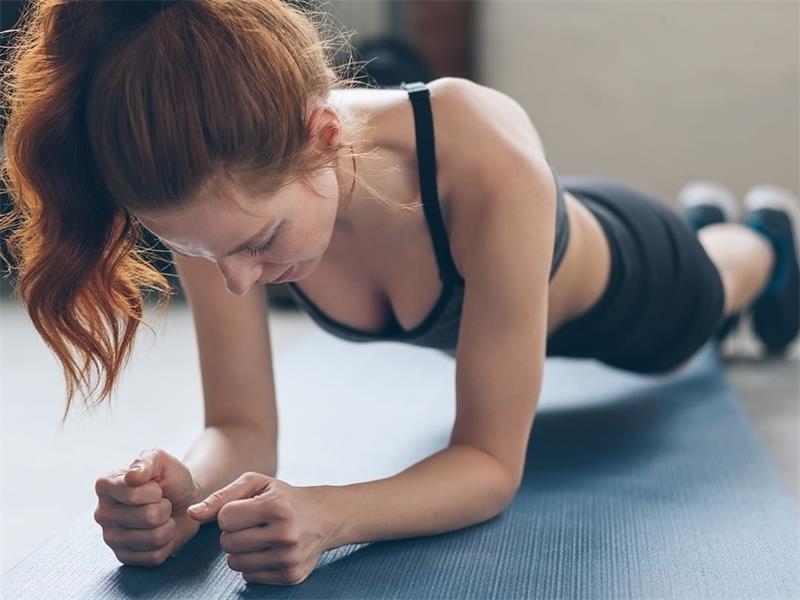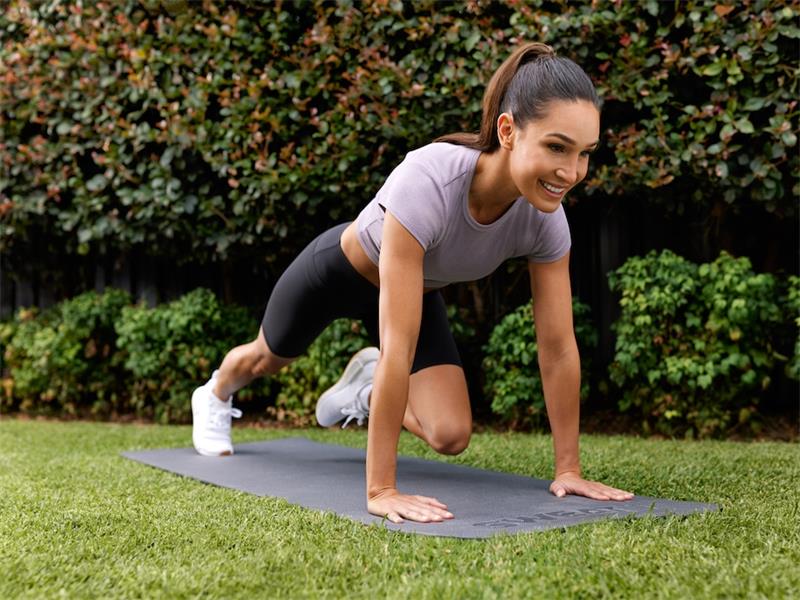Contents
- 1 The Convenience and Accessibility of Bodyweight Exercises
- 2 The Benefits of Incorporating Bodyweight Exercises into Your Fitness Routine
- 3 Squats
- 4 The Push-Up: A Classic Bodyweight Exercise
- 5 Plank
- 6 Lunges: Step-by-Step Guide
- 7 Variations: Walking Lunges & Reverse Lunges
- 8 Muscle Groups Targeted
- 9 Burpees: The Challenging Yet Rewarding Exercise
- 10 Conclusion
The Convenience and Accessibility of Bodyweight Exercises
Are you tired of paying expensive gym membership fees or feeling intimidated by the weight room? Do you struggle to find time or motivation to exercise regularly? Good news – bodyweight exercises are here to save the day!
One of the best things about bodyweight exercises is that they can be done anywhere, at any time. All you need is a little bit of space and your own body weight.
No fancy equipment is required! Bodyweight exercises are incredibly convenient for busy individuals who don’t have a lot of spare time.
You can squeeze in a quick workout during your lunch break, while watching TV, or even before bed. And because there’s no equipment involved, you don’t need to worry about taking extra time to set up or clean up.
The Benefits of Incorporating Bodyweight Exercises into Your Fitness Routine
But convenience isn’t the only advantage of bodyweight exercises. They also provide numerous benefits for your overall health and fitness. For starters, bodyweight exercises are great for building functional strength – that is, the strength that translates to everyday activities like lifting groceries or climbing stairs.
Additionally, many bodyweight exercises target multiple muscle groups at once, making them an efficient way to work out your entire body in a short amount of time. And because they require you to engage your core muscles for stability and balance, they can help improve your posture and reduce the risk of injury.
Another benefit of bodyweight exercises is that they’re adaptable to all fitness levels. Whether you’re a beginner or an experienced athlete, there are endless variations and modifications available to suit your needs and challenge yourself as you progress.
Incorporating bodyweight exercises into your fitness routine can also help increase cardiovascular endurance and burn calories for weight loss or maintenance. Plus, they’re a great way to mix up your workout routine if you’re feeling bored with traditional gym machines or free weights.
Overall, bodyweight exercises are a convenient, versatile, and effective way to improve your fitness and stay healthy. So why not give them a try?
Squats
How to Perform a Proper Squat
Squats are one of the best bodyweight exercises you can do, as they target multiple muscle groups and improve overall lower body strength. To perform a proper squat:
1. Stand with your feet shoulder-width apart and keep your back straight.
2. Lower yourself down by bending at the knees and hips until your thighs are parallel to the ground.
3. Make sure your knees do not extend beyond your toes when you lower yourself.
4. Push back up through your heels to return to the starting position.
Remember, proper form is important to avoid injury and get optimal results. Keep your core engaged throughout the movement and exhale as you push up from the squat.
Variations: Jump Squats and Pistol Squats
For those looking for an extra challenge, there are several variations of squats that can increase the intensity and target different muscle groups. Jump squats involve adding a jump at the end of each squat repetition, which increases explosive power in your legs while also challenging your cardiovascular system.
Pistol squats involve standing on one leg while lowering yourself into a squat position with the other leg extended in front of you. This variation targets single-leg strength and stability while also improving balance.
Muscle Groups Targeted
Squats primarily work out the glutes, quadriceps, hamstrings, and calf muscles. The glutes get activated during both hip extension (rising) and hip flexion (lowering).
Quadriceps work hard when lowering into deep squats as well as lifting back up again by extending at the knee joint. Hamstrings keep you stable throughout this movement by working eccentrically (stretching under load) when lowering down into deep positions then concentrically (shortening under load) when lifting back up again.
Calf muscles get activated during the ascent, as they help to push you up through your feet. Incorporating squats into your workout routine will definitely strengthen these muscle groups, and the variety of squat variations makes it easy to explore and find the best option for you.
The Push-Up: A Classic Bodyweight Exercise
Push-ups are undoubtedly one of the most well-known and popular bodyweight exercises. They are often included in fitness routines because they are effective at targeting multiple muscle groups, including the chest, triceps, and core. However, proper form is essential to ensure maximum benefit from push-ups.
Proper Form for Push-Ups
To perform a standard push-up, start in a high plank position with your hands shoulder-width apart and your feet together. Engage your core muscles to keep your body in a straight line from head to heels.
Lower yourself toward the ground by bending your elbows until they reach a 90-degree angle. Then, push yourself back up to starting position by extending your arms fully.
It’s important to maintain proper form throughout the exercise. Keep your elbows close to your body rather than flaring them outwards.
Don’t let your lower back sag or pike up – keep everything aligned! If you find it difficult to maintain proper form while performing this exercise on the ground, try doing it against a wall instead.
Variations of Push-Ups
If you’re looking for ways to make push-ups more challenging or interesting, there are many variations available. One example is diamond push-ups which target the triceps more intensely since they require a narrower hand placement than standard push-ups.
Another variation is decline push-ups which involve placing your feet on an elevated surface such as a bench or step while performing the exercise. This variation puts more emphasis on the upper chest muscles.
Benefits of Push-Ups
Push-ups have numerous benefits beyond just building upper body strength – they also help improve core strength and stability since these muscles must be engaged throughout the movement. Additionally, doing multiple sets of push-ups can help increase cardiovascular endurance over time. Moreover, push-ups can be done easily anywhere, and they don’t require any equipment.
This is why they are a perfect exercise for anyone looking to get fit without needing access to a gym or fancy equipment. Start doing push-ups today, and you’ll soon notice the amazing changes in your body!
Plank
Form is Key
If you’re looking to strengthen your core muscles, the plank is a great exercise to add to your routine. To perform a proper plank, start in a push-up position with your arms extended and your hands shoulder-width apart. Lower yourself down onto your forearms, keeping your elbows directly under your shoulders.
Your body should be in a straight line from head to heels, with your core engaged and glutes squeezed tight. Hold the position for as long as you can without letting your hips sag or raising them too high.
Get Creative with Variations
To switch things up and challenge yourself even more, try adding variations like side planks or plank jacks into your routine. Side planks are performed by starting in the plank position on one forearm and then rotating so that you are balancing on one arm and the side of one foot.
This variation specifically targets the oblique muscles. Plank jacks involve starting in a regular plank position but instead of holding it stationary, jump both feet out at once as you would during jumping jacks.
A Strong Core Leads to Better Health
The benefits of incorporating planks into your fitness routine are numerous. Planks not only help build strength and stability in the abdominal muscles but also work other muscle groups such as hips, shoulders and lower back muscles which ultimately improve overall posture and balance.
A strong core is essential for everyday tasks such as lifting heavy objects or even standing for prolonged periods of time without experiencing discomfort. Additionally, strengthening these muscles can reduce back pain caused by poor posture or weak muscles surrounding the spine leading to improved quality of life overall!
Lunges: Step-by-Step Guide
Lunges are one of the most effective and easy-to-do bodyweight exercises that can be done anywhere. They are excellent for building lower body strength, toning your legs, and glutes and improving your balance.
Lunges require no special equipment or gym memberships and can be performed in any open space. Here’s how to do them properly:
1. Stand with your feet shoulder-width apart
2. Take a step forward with one leg, keeping your upper body straight
3. Bend both knees to form roughly 90-degree angles
4. Push back up to a standing position using your front heel
5. Repeat the same motion with the other leg When performing lunges, ensure that your front knee does not go past your toes and keep your core tight throughout the exercise.
Variations: Walking Lunges & Reverse Lunges
Walking lunges involve taking a step forward, completing a lunge on that leg before stepping forward again with the opposite leg for another lunge repetition. Reverse lunges involve stepping backward instead of forward as you would in regular lunges.
This variation reduces pressure on joints such as knees and is therefore favorable for those who may suffer from joint issues. Both variations work different muscle groups than traditional lunges while still targeting lower body strength.
Muscle Groups Targeted
Lunges are known for targeting multiple muscle groups simultaneously which makes them an excellent exercise for overall lower body strength development. The primary muscles worked during lunges are the quadriceps (front of thigh), hamstring (back of thigh), glutes (butt) and calves (back lower-leg muscles). However, they also engage hip flexors which help stabilize the pelvis during movement making it an exceptionally effective exercise for improving balance overall.
Burpees: The Challenging Yet Rewarding Exercise
Burpees are one of the most challenging and rewarding bodyweight exercises out there. It’s a full-body exercise that targets multiple muscle groups, including your legs, glutes, arms, chest and core.
It’s also a great cardio exercise that can help improve your cardiovascular endurance. In this section, we’ll discuss how to perform burpees properly, modifications for beginners or those with injuries and the benefits of incorporating burpees into your fitness routine.
How to do a Burpee
To perform a burpee properly, follow these steps:
1. Begin in a standing position.
2. Drop down into a squat position with your hands on the ground in front of you.
3. Kick your feet back into a plank position while keeping your arms extended.
4. Perform push up.
5. Jump feet back to starting position.
6. Jump up as high as possible. It’s important to maintain proper form throughout the exercise to avoid injury and get maximum benefits from it.
Modifications for Beginners or Those with Injuries
If you’re new to burpees or have an injury that prevents you from performing them correctly, there are modifications that can make it easier. One modification is to eliminate the jumping portion of the burpee by stepping instead of jumping backward and forward between each rep.
Another modification is elevated push-up variation where you place hands on an elevated surface like box or bench instead of floor-level push-up. Remember that modifications should be temporary until you can perform full burpees safely without risking further injury or discomfort.
The Benefits of Burpees
Burpees have numerous benefits beyond just building strength and endurance in various muscles group mentioned above. They’re also great for improving cardiovascular health by getting your heart rate up quickly with just one movement pattern – making them an excellent choice for time-efficient workouts.
In addition, burpees can help promote calorie burn, which makes them a great addition to any weight loss routine. Overall, incorporating burpees into your fitness routine is an excellent way to get a challenging workout in any location and see results quickly.
Conclusion
If you’re looking to get in shape or maintain good health, bodyweight exercises are a great option. They’re convenient, accessible and effective for improving strength, flexibility and cardiovascular endurance. In this article, we’ve discussed five of the best bodyweight exercises you can do anywhere: squats, push-ups, plank, lunges and burpees.
Recap
Squats target your lower body muscles such as glutes, quads and hamstrings. Push-ups are great for chest and triceps strength and help improve core stability.
Plank is an isometric exercise that targets your core muscles while lunges work your lower body muscles in a different way than squats do. Burpees provide a full-body workout that improves cardiovascular endurance while also strengthening many major muscle groups.
Encouragement
We encourage you to try these exercises at home or wherever you are! Start with beginner variations if needed and gradually work your way up to advanced versions as you build strength and confidence. You don’t need a gym membership or fancy equipment to get fit – just yourself!
Remember to warm up properly before exercising and cool down afterwards with some stretching. Incorporating just a few of these exercises into your fitness routine can make a big difference over time.
You’ll feel stronger, more flexible and have better endurance. Plus, doing bodyweight exercises can be fun – challenge yourself to see how many reps you can do or try adding them into a circuit for a full-body workout.
We hope this article has inspired you to give these five bodyweight exercises a try! Even if you’re busy or traveling – there’s no excuse not to exercise when all it takes is using your own body weight!












